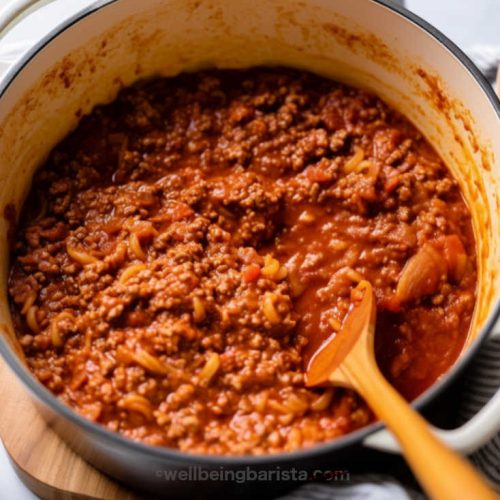
Authentic Ragù Bolognese (Pappardelle Alla Bolognese)
Experience the rich flavors of authentic Ragù Bolognese atop tender pasta --- Pappardelle alla Bolognese a delightful protein-rich experience!
Equipment
- Kitchen knife
- Pot or Dutch oven (min 20 cm diameter)
- Wooden spoon or spatula:
- Grater (optional):
- Large pot (for cooking pasta)
- Colander or pasta strainer
- Serving dish
Ingredients
For the classic ragù Bolognese
- 3 tablespoons olive oil extra virgin
- 50 g butter (1¾ oz) unsalted
- 65-75 g yellow onion (2½ oz) finely minced
- 50 g carrots (1¾ oz) peeled and very finely minced
- 42.5 g celery (1½ oz) very finely minced
- 150 g pancetta (or mix of pancetta and ground pork) (5½ oz) minced
- 350 g ground beef (12½ oz)
- Freshly ground nutmeg to taste (optional)
- 200 ml red wine (⅘ cup)
- 300 grams Italian peeled tomatoes (10⅓ oz)
- 500 ml Italian meat broth or vegetable broth (2 cups)
- 1 tablespoon tomato paste
- Salt to taste
- Freshly ground black pepper as needed
- 2 tablespoons milk
For the Pappardelle alla Bolognese
- 500 g Egg pappardelle (17.6) oz
Instructions
Authentic Ragù Bolognese
- After cleaning the vegetables, finely chop the onion, carrot, and celery as fine as possible with a kitchen knife for the “soffritto” and set aside.
- In a pot or Dutch oven (at least 20 cm in diameter), heat a drizzle of olive oil and melt the butter over medium heat for a few minutes.
- Once the butter has melted, cook the onion slowly with a pinch of salt, stirring frequently until it becomes soft and translucent. This might take from 5-10 minutes.
- Next, add the celery and the carrot together with another pinch of salt stirring often for around 5 minutes.
- Once the vegetables are caramelized (between 10 and 15 minutes), add the finely chopped pancetta (or ground pork mix) stirring the mixture to break it apart. Increase the heat to medium-low to facilitate the cooking of the pancetta and the release of its fat. Cook the "soffritto" and pancetta together, allowing their flavors to meld without browning for another 10 to 15 minutes.
- With the vegetables and bacon cooked, now it is time to add the ground beef to the pan. Spread the pancetta and vegetables around the edges of the pot, creating space in the center for the meat. Increase the heat to medium-high and add one-third of the meat with salt. Stir continuously to fully break up the meat and prevent it from releasing excess liquid. Once the meat begins to change color, move it to the sides and add another third with salt. Repeat this process until all the meat is browned and fully cooked and there are no big chunks left.
- Season with salt and pepper and cook, stirring for a few minutes. Optionally add a generous grating of freshly ground nutmeg to add warmth and depth to the ragù Bolognese.
- Deglaze with half of the red wine leaving it to evaporate slowly. Keep the heat on high for a couple of minutes, stirring again until the wine alcohol evaporates. Then repeat with the remaining wine. This step requires a little patience and may take up to 25 minutes but it's important not to leave any traces of wine before pouring the tomatoes.
- Stir in hand-crushed tomatoes and simmer covered for 30 minutes.
- Cook for about 3 and a half hours, stirring occasionally and checking the consistency of the ragù (add salt, pepper, or more water if needed). Always keep the lid on, please! About 30 minutes before turning off the heat, you can add the milk to give the ragù more creaminess and reduce the acidity of the tomatoes.
- Finally season with salt and pepper. If you're using the sauce of lasagne then you might need to cook it for longer until it becomes denser.
Pappardelle alla Bolognese
- Bring a large pot of salted water to a rolling boil. The water should be generously salted, similar to seawater.
- Carefully add the pappardelle to the boiling water. Use a gentle stirring motion to prevent the pasta from sticking together. Allow the pasta to cook, stirring occasionally, according to the package instructions or until it reaches the desired level of doneness. Fresh pasta like pappardelle all'uovo typically cooks much faster than dried pasta, usually within 3-5 minutes.
- Taste the pasta to check for doneness. It should be al dente, meaning it's tender but still has a slight firmness to it. Once the pasta is cooked to your liking, drain it in a colander or pasta strainer.
- Transfer the cooked pappardelle to a serving dish or directly into the ragù Bolognese sauce. Toss the pasta with the sauce until evenly coated
- Serve hot, garnished with freshly grated Parmesan cheese if desired.